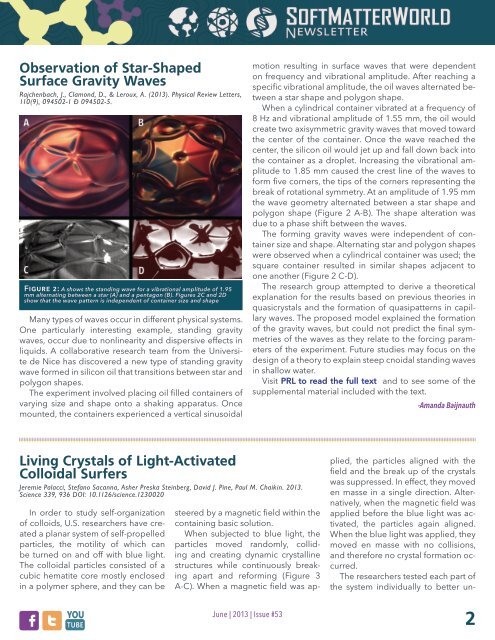Mapping the Mechanical Stiffness of Live Cells ... - Soft Matter World
Mapping the Mechanical Stiffness of Live Cells ... - Soft Matter World
Mapping the Mechanical Stiffness of Live Cells ... - Soft Matter World
Create successful ePaper yourself
Turn your PDF publications into a flip-book with our unique Google optimized e-Paper software.
Observation <strong>of</strong> Star-ShapedSurface Gravity WavesRajchenbach, J., Clamond, D., & Leroux, A. (2013). Physical Review Letters,110(9), 094502-1 Ð 094502-5.Figure 2: A shows <strong>the</strong> standing wave for a vibrational amplitude <strong>of</strong> 1.95mm alternating between a star (A) and a pentagon (B). Figures 2C and 2Dshow that <strong>the</strong> wave pattern is independent <strong>of</strong> container size and shapeMany types <strong>of</strong> waves occur in different physical systems.One particularly interesting example, standing gravitywaves, occur due to nonlinearity and dispersive effects inliquids. A collaborative research team from <strong>the</strong> Universitede Nice has discovered a new type <strong>of</strong> standing gravitywave formed in silicon oil that transitions between star andpolygon shapes.The experiment involved placing oil filled containers <strong>of</strong>varying size and shape onto a shaking apparatus. Oncemounted, <strong>the</strong> containers experienced a vertical sinusoidalmotion resulting in surface waves that were dependenton frequency and vibrational amplitude. After reaching aspecific vibrational amplitude, <strong>the</strong> oil waves alternated betweena star shape and polygon shape.When a cylindrical container vibrated at a frequency <strong>of</strong>8 Hz and vibrational amplitude <strong>of</strong> 1.55 mm, <strong>the</strong> oil wouldcreate two axisymmetric gravity waves that moved toward<strong>the</strong> center <strong>of</strong> <strong>the</strong> container. Once <strong>the</strong> wave reached <strong>the</strong>center, <strong>the</strong> silicon oil would jet up and fall down back into<strong>the</strong> container as a droplet. Increasing <strong>the</strong> vibrational amplitudeto 1.85 mm caused <strong>the</strong> crest line <strong>of</strong> <strong>the</strong> waves t<strong>of</strong>orm five corners, <strong>the</strong> tips <strong>of</strong> <strong>the</strong> corners representing <strong>the</strong>break <strong>of</strong> rotational symmetry. At an amplitude <strong>of</strong> 1.95 mm<strong>the</strong> wave geometry alternated between a star shape andpolygon shape (Figure 2 A-B). The shape alteration wasdue to a phase shift between <strong>the</strong> waves.The forming gravity waves were independent <strong>of</strong> containersize and shape. Alternating star and polygon shapeswere observed when a cylindrical container was used; <strong>the</strong>square container resulted in similar shapes adjacent toone ano<strong>the</strong>r (Figure 2 C-D).The research group attempted to derive a <strong>the</strong>oreticalexplanation for <strong>the</strong> results based on previous <strong>the</strong>ories inquasicrystals and <strong>the</strong> formation <strong>of</strong> quasipatterns in capillarywaves. The proposed model explained <strong>the</strong> formation<strong>of</strong> <strong>the</strong> gravity waves, but could not predict <strong>the</strong> final symmetries<strong>of</strong> <strong>the</strong> waves as <strong>the</strong>y relate to <strong>the</strong> forcing parameters<strong>of</strong> <strong>the</strong> experiment. Future studies may focus on <strong>the</strong>design <strong>of</strong> a <strong>the</strong>ory to explain steep cnoidal standing wavesin shallow water.Visit PRL to read <strong>the</strong> full text and to see some <strong>of</strong> <strong>the</strong>supplemental material included with <strong>the</strong> text.-Amanda BaijnauthLiving Crystals <strong>of</strong> Light-ActivatedColloidal SurfersJeremie Palacci, Stefano Sacanna, Asher Preska Steinberg, David J. Pine, Paul M. Chaikin. 2013.Science 339, 936 DOI: 10.1126/science.1230020In order to study self-organization<strong>of</strong> colloids, U.S. researchers have createda planar system <strong>of</strong> self-propelledparticles, <strong>the</strong> motility <strong>of</strong> which canbe turned on and <strong>of</strong>f with blue light.The colloidal particles consisted <strong>of</strong> acubic hematite core mostly enclosedin a polymer sphere, and <strong>the</strong>y can beJune | 2013 | Issue #53steered by a magnetic field within <strong>the</strong>containing basic solution.When subjected to blue light, <strong>the</strong>particles moved randomly, collidingand creating dynamic crystallinestructures while continuously breakingapart and reforming (Figure 3A-C). When a magnetic field was applied,<strong>the</strong> particles aligned with <strong>the</strong>field and <strong>the</strong> break up <strong>of</strong> <strong>the</strong> crystalswas suppressed. In effect, <strong>the</strong>y moveden masse in a single direction. Alternatively,when <strong>the</strong> magnetic field wasapplied before <strong>the</strong> blue light was activated,<strong>the</strong> particles again aligned.When <strong>the</strong> blue light was applied, <strong>the</strong>ymoved en masse with no collisions,and <strong>the</strong>refore no crystal formation occurred.The researchers tested each part <strong>of</strong><strong>the</strong> system individually to better un-2


